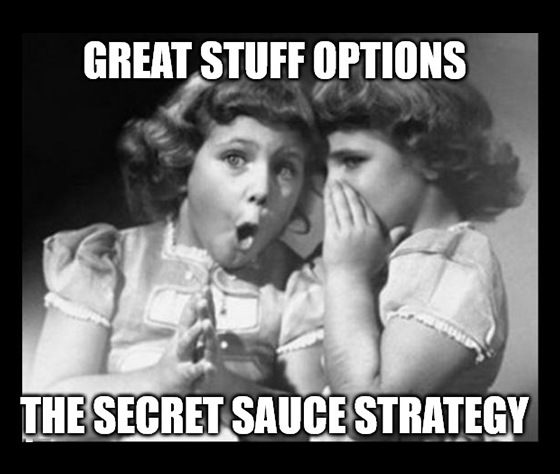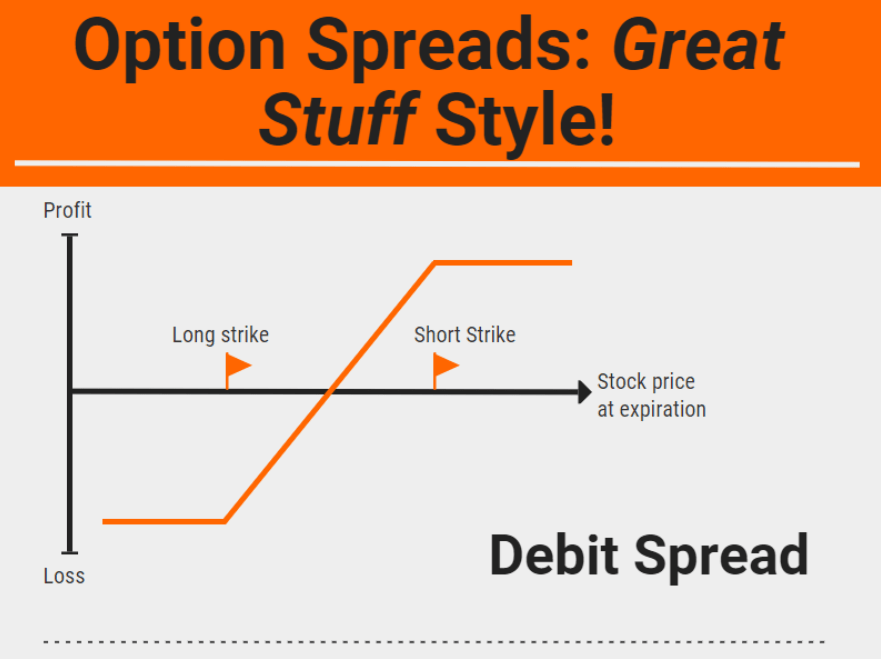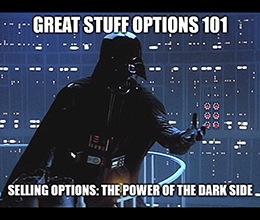
Great Stuff Special Edition: The “Secret Sauce” Strategy
This is it, campers: the third and final day of Great Stuff’s primer on options trading!
If you’ve been following along, you know that we’ve covered the basics from “What is an option?” to “What are puts and calls?” all the way to how to buy and sell options.
If you haven’t been following along, I strongly urge you to read our first two lessons before going any further:
- Day 1: “Great Stuff Special Edition: Options 101”
- Day 2: “Great Stuff Special Edition: Options — The Dark Side”
All caught up? Excellent!
Today, we saved the best for last: It’s time to talk about one of my all-time favorite options trading strategies. It’s the picture-perfect package…
This strategy:
- Keeps greed from running wild.
- Sets your expectations before you get into the trade.
- Reduces your capital exposure to the trade.
- Makes volatility work for you!
What is this magical options trading strategy?
It’s called a debit spread.
Now, I can already hear sighs from the more experienced options traders out there. But debit spreads are boring … that’s your big secret?
Yes … for all the reasons I listed above. Debit spreads accomplish one critical thing for options traders of all walks of life: They remove greed from the equation.
See, we live in an age where any Joe Schmo in an online message board (you know the one I’m talking about) can throw darts at a wall … and end up with godlike, bazillion-percent gains through sheer dumb luck. It’s gambling with extra steps. Remember, you never hear from the hordes of scratch-off lotto losers…
Temperance, my friends, will make you more money than any one-off trade. Everyone loves the “ooh, flashy!” 1,000% trades. Sometimes, those once-in-a-lifetime setups do pop up … but it’s as rare as I like my steak. (If it ain’t mooing, I ain’t chewing!)
Therein lies the beauty of debit spreads. Once you know what to look for, you can bank on these trades again … and again … and again … and again…
Debit Spread: An Options Trader’s Savior
So, what exactly is a debit spread?
A debit spread is like buying a put or a call on a stock, but adding a little insurance … just in case. That insurance comes in the form of selling another option at the same time.
But Egon, I thought you said crossing the streams (selling options) was bad?
When you sell an option by itself, yes, that can have serious repercussions — if you’re not careful. However, when you enter a debit spread, the option you buy covers for the option you sell.
Let’s look at an example, and you’ll see what I mean. Just so we’re all on the same page, here’s how this trade would work without using a spread.
Say you’ve followed fictional company XYZ Inc. for a while now, and you’re convinced the stock will go up.
XYZ shares trade for $10, and you believe the stock will rise to at least $12 by the end of May. When you go to buy XYZ options, you see that the May $11 strike call sells for $1 (or $100 per contract).
Doing a little math — $11 + $1 for the option = $12 — you realize that you need XYZ to rally to $12 before your May call option expires just to make back the $1 you spent to buy the option. If you’re right, and XYZ rallies to $13 when your option expires, you can sell your option for $2 and bank a 100% gain.
(Remember: All of these options prices should be multiplied by 100 to get the actual cost of the full contract. For simplicity’s sake, we’re going to leave out that step going forward. The results are still the same.)
But what if you’re only just barely right, and XYZ sits steady at $12 when your option expires? Well … then it’s “You win nothing. Good day, sir!”
In this situation, debit spreads are your best way to realize a 100% gain on XYZ. To do so, you’d buy an XYZ May $11 call and sell a May $12 call. In other words, you have one long strike (where you buy the option) and one short strike (where you sell the option).
Why sell the May $12 call? Because that’s as high as your research has told you that XYZ will go. And, lo and behold, the XYZ $12 call trades for $0.50.
So, you pay $1 for the May $11 call and receive $0.50 for selling the May $12 call. Your total cost for the XYZ May debit spread is $0.50. Can you see where this is going yet?
In the end, you were right! XYZ rallies to $12.
If you had just bought the $11 call, you get nothing. However, since you also sold the $12 call, you net $0.50 on the trade — a 100% gain from the $0.50 you initially invested.
Bu, Mr. Great Stuff, what if that sold call gets exercised!? Will I have to pay for any shares?
Don’t worry, you’re covered. You or your broker will exercise the purchased $11 call. Not only are you covered, you still get your 100% gain — buy XYZ for $11, sell it for $12.
Note: Gains and losses do not include any fees or costs your broker may charge.
Here’s a handy little graph to show you what this trade would look like. The orange line shows your journey between profit and loss as the stock’s price moves between your two strike prices:

You can also use this same strategy if you expect XYZ shares to fall. Simply use puts instead of calls. Then, set your expectations and targets accordingly.
For instance, if your research tells you that XYZ will fall to $8, you might buy the May $9 strike put and sell the May $8 strike put.
The Pros and Cons of Debit Spreads
I know I laid out all the reasons why I like using debit spreads at the beginning, but let’s recap those now that you’ve seen an example. Plus, I’ll throw in the obvious downside to this strategy.
Pros:
- Your maximum loss is the money you put into the trade.
- You know exactly what your maximum profit will be.
- You can lower your overall cost to enter the trade — potentially putting options on expensive stocks within your reach.
- Since your profit is capped when the stock hits your sold strike, your trade has a definite exit point. There’s no greed to tempt you to hold longer and potentially lose everything! Take the money and run.
- You can get triple-digit gains on smaller moves in a stock. (Notice how we turned a potentially 0% gain into a 100% gain in the example above by selling the call?)
- You still hit your profit target even if the options get exercised.
Cons:
- No exposure to extended rallies or declines in a stock — i.e., “opportunity cost.”
As you can see, debit spreads have quite a few benefits. However, my personal favorite is also the biggest downside to using this strategy. Unlike buying basic calls and puts, no matter how high a stock rallies or how low a stock falls, your maximum return on a debit spread is already set in stone.
To me, this is a big benefit. There’s no emotion or greed driving you to keep holding that trade for one more day to see if you can squeeze out a few more dollars. Once the stock hits the strike price of your sold option, that’s it. You’re done. Close out the trade, collect your profit and find the next opportunity.
It’s less exciting than watching a stock rally obscenely high, knowing you bought a call on those shares. But it’s also less nerve-wracking when the market suddenly moves against your position. And if it does? You already lowered your cost to enter the trade. It won’t sting as bad as if your expensive call or put goes down the drain.
As with all trading, deciding to use debit spreads ultimately depends on your risk tolerance and your investment goals.
Debit Spreads: Preparation’s the Key
The key to using debit spreads lies in the preparation. You won’t always find convenient prices like those for XYZ Inc. (It’s a fake company anyway.)
You must do your due diligence. You must do the math to make sure the trade will work out in your favor. In other words, if you just want to place YOLO call bets and live or die by the market’s whims … this strategy isn’t for you.
You need to have an idea of how high or how low the stock’s value will go. By doing so, you can set the upside (or downside) target for the stock and find the appropriate options to buy and sell for your spread.
Honestly, these are all things any options trader should do anyway — even for basic calls and puts.
If you haven’t done your research…
If you haven’t set a target gain for your trade…
If you haven’t set a target move for the stock you’re trading options on…
You’re doing it wrong.
Using the debit spread strategy correctly forces you to do these things. It helps you create good trading habits that will help you in other areas of investing as well. And that’s how you’ll keep making money in the options market time and time again — while other highfliers have already lost their shirts searching for “that one perfect trade.”
So, that’s it! That’s Great Stuff’s three-day options bender.
I hope we taught you something useful and made you feel a bit more comfortable about trading options.
Awesome as they are, Banyan Hill’s experts have yet to use debit spreads in their trading services. (Keyword: yet!) I guess this strategy’s just the “secret sauce” you only get by reading Great Stuff!
Although, I see some of you didn’t take up the offer I sent you the other day. You know, about Paul ’s romp through the options market?
Remember … I had to sweet-talk the right ears to make this happen … to reopen this offer and give you the chance to sign up.
Click here to learn more about trading options in Rebound Profit Trader.
But Mr. Great Stuff, my thirst for more options action cannot be quenched! What else do ya got?
My, have I already instilled the remarkable beauty of options in you? Excellent! Banyan Hill expert Chad Shoop has you covered.
Click here to learn all about Chad’s put-selling strategy in Pure Income.
Remember, if you have any questions, feel free to send them to us at GreatStuffToday@banyanhill.com, and we’ll see what we can do!
And if you’re still craving more Great Stuff, you can check us out on social media: Facebook and Twitter.
Until next time, good trading!
Regards,

Joseph Hargett
Editor, Great Stuff









